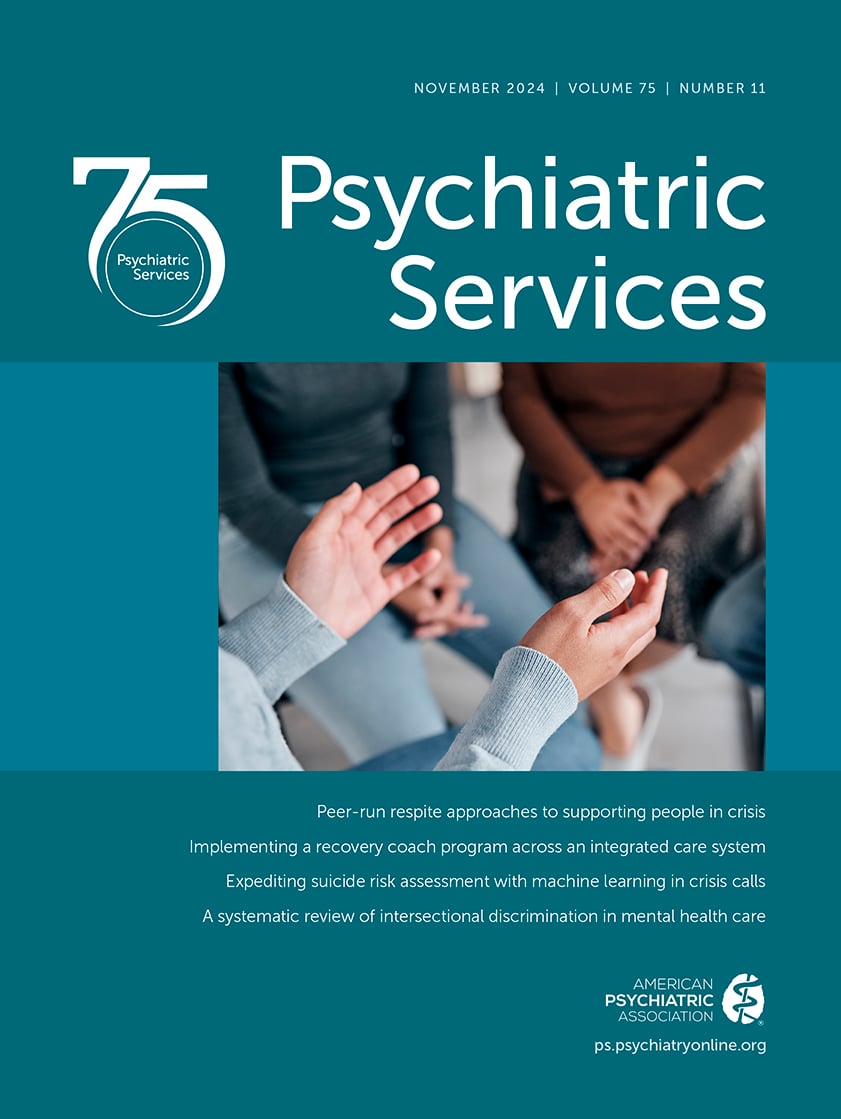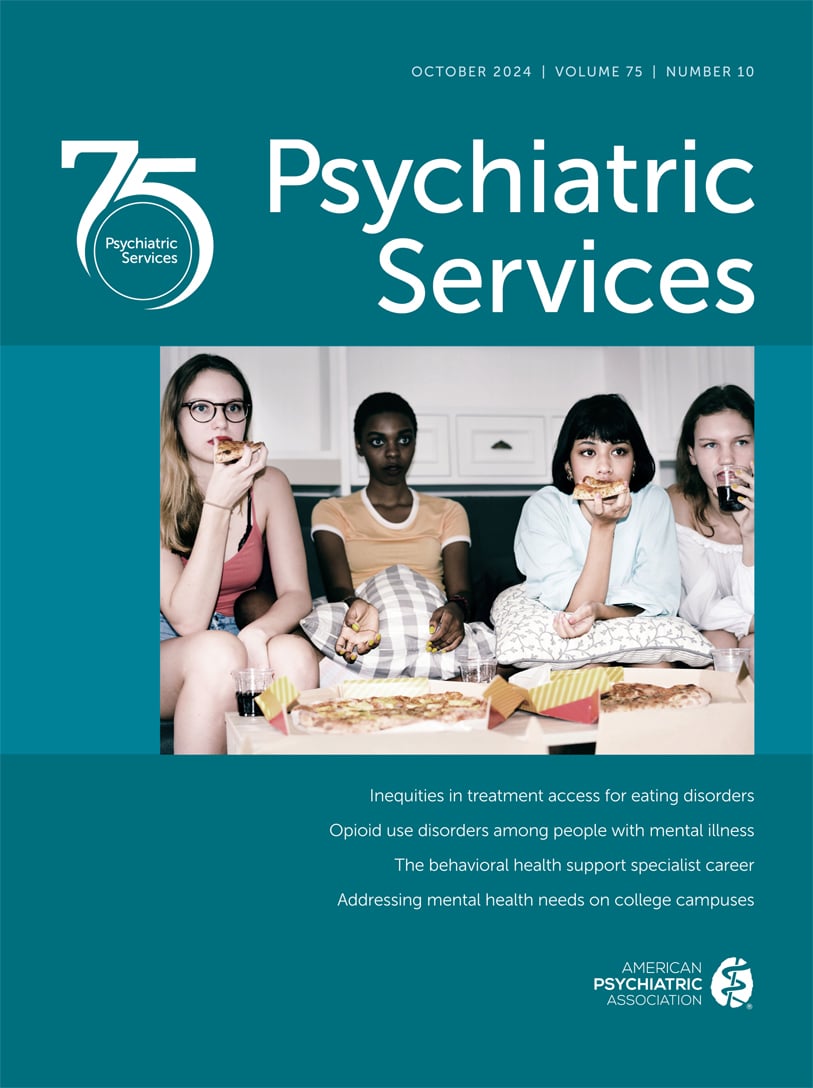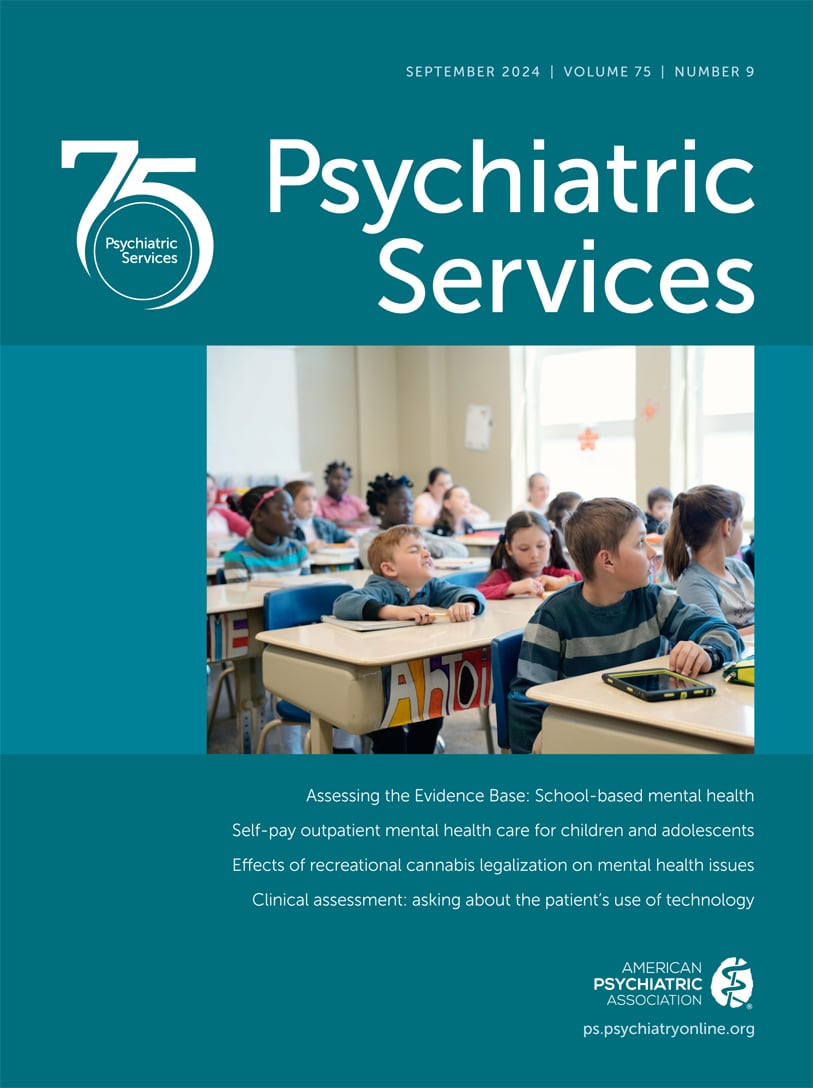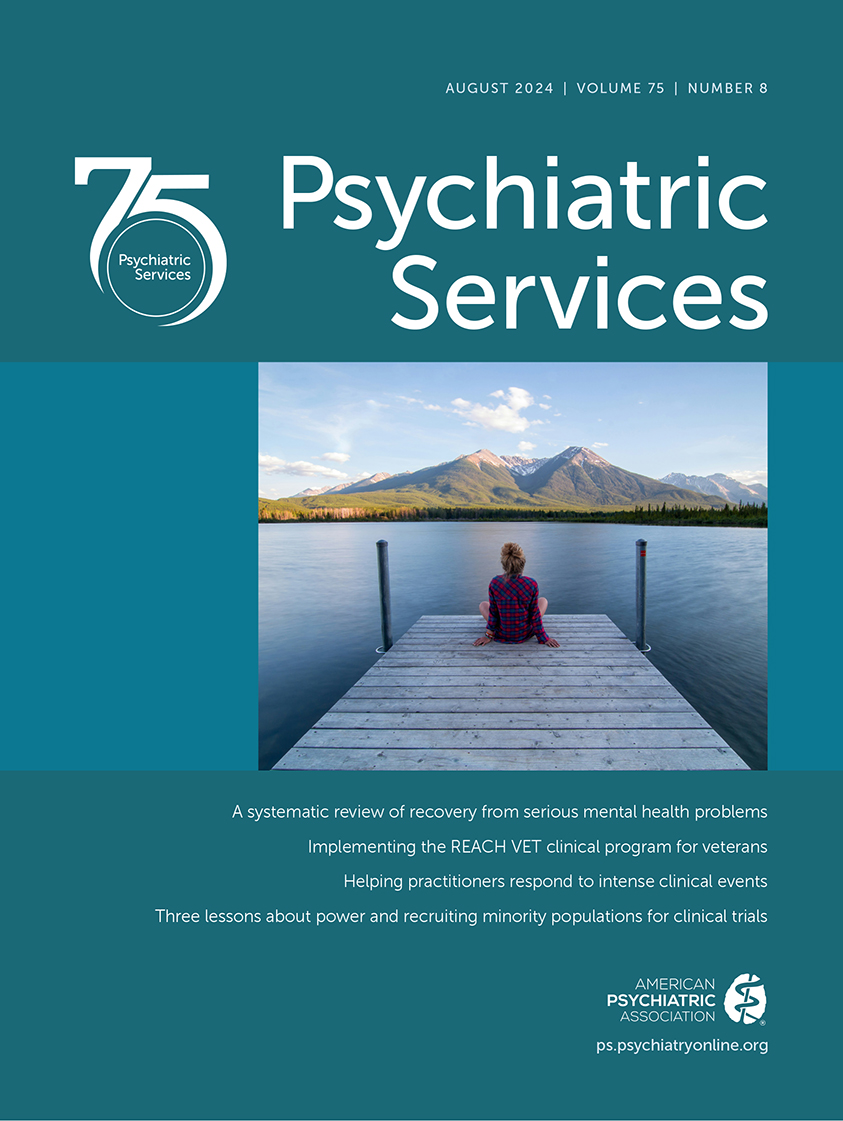Psychiatric Services
- Volume 57
- Number 1
- January 2006
Taking Issue
This Month's Highlights
Special Report
Columns
Publication date: 01 January 2006
Pages18–20Dr. Appelbaum reviews the past 25 years of the Law & Psychiatry column, of which he has been the editor since the column's initiation by John Talbott, M.D. The column has included contributions from Dr. Appelbaum as well as from various other mental ...
https://doi.org/10.1176/appi.ps.57.1.18Publication date: 01 January 2006
Pages21–23A performance improvement initiative was undertaken at a state psychiatric hospital to reduce antipsychotic polypharmacy. Data from physicians' order forms were used to document the prescribing practices of 14 psychiatrists in November 2001 and in August ...
https://doi.org/10.1176/appi.ps.57.1.21Publication date: 01 January 2006
Pages24–26The Internet is not only a vital medium for communication, entertainment, and commerce, but it is also an outlet for illicit drug sales. Although the U.S. Controlled Substances Act regulates access to certain drugs by requiring prescriptions, unique ...
https://doi.org/10.1176/appi.ps.57.1.24Publication date: 01 January 2006
Pages31–33A planning and implementation group was created to respond to a severe shortage of public-sector children's inpatient beds in New Orleans. This group identified a large gap in the continuum between the inpatient unit, with its wide range of resources, and ...
https://doi.org/10.1176/appi.ps.57.1.31Publication date: 01 January 2006
Pages34–36Management of changes in physiologic and mental status due to alcohol is a core skill utilized in the psychiatric emergency service. Blood alcohol concentrations are commonly approximated by measuring breath alcohol at triage. However, the blood-breath ...
https://doi.org/10.1176/appi.ps.57.1.34Article
Publication date: 01 January 2006
Pages37–47This paper is based on a report commissioned by the Subcommittee on Mental Health Interface With General Medicine of the Presidents New Freedom Commission on Mental Health. Although mental and medical conditions are highly interconnected, medical and ...
https://doi.org/10.1176/appi.ps.57.1.37Publication date: 01 January 2006
Pages48–55OBJECTIVE: Little is known about the long-term success of quality improvement efforts for the treatment of depression in primary care. This study assessed factors associated with the successful implementation, maintenance, and spread of such efforts. ...
https://doi.org/10.1176/appi.ps.57.1.48Publication date: 01 January 2006
Pages56–62OBJECTIVE: Treatment nonadherence has been identified as an understudied, yet frequent, cause of relapse among patients with bipolar disorder. This study evaluated factors related to treatment adherence. METHODS: This study was a cross-sectional analysis ...
https://doi.org/10.1176/appi.ps.57.1.56Publication date: 01 January 2006
Pages63–69OBJECTIVES: Few psychotropic medications are approved for use among children younger than 18 years. Yet previous studies have shown an increase in the use of psychotropic medications among school-age children and adolescents. Most previous studies ...
https://doi.org/10.1176/appi.ps.57.1.63Publication date: 01 January 2006
Pages70–76OBJECTIVE: When new medications are introduced, a period of diffusion, evaluation, and adoption follows. This study evaluated the influence of patient- and facility-level characteristics on the early use of a new antipsychotic, ziprasidone, among ...
https://doi.org/10.1176/appi.ps.57.1.70Publication date: 01 January 2006
Pages77–83OBJECTIVE: This study compared patients with both mental retardation and a psychiatric diagnosis with patients who did not have co-occurring mental retardation who were served in Ontario's tertiary mental health care system in terms of demographic ...
https://doi.org/10.1176/appi.ps.57.1.77Publication date: 01 January 2006
Pages84–92OBJECTIVE: This study examined the use of and perceived need for alcohol treatment services among adolescents (aged 12 to 17 years) who received mental health services in the previous year compared with same-aged adolescents who did not receive such ...
https://doi.org/10.1176/appi.ps.57.1.84Publication date: 01 January 2006
Pages93–99OBJECTIVE: Use of longitudinal data can help clarify the extent of persistent need for services or persistent problems in gaining access to services. This study examined the level of transient and persistent need and unmet need over time among respondents ...
https://doi.org/10.1176/appi.ps.57.1.93Publication date: 01 January 2006
Pages100–106OBJECTIVE: This study assessed the effect of cognitive-behavioral therapy on a range of problems associated with complex trauma in a sample of women with comorbid substance use disorders and posttraumatic stress disorder (PTSD). METHODS: A total of ...
https://doi.org/10.1176/appi.ps.57.1.100Publication date: 01 January 2006
Pages107–113OBJECTIVES: This study examined the rates of sexual and physical abuse and suicide attempts among male and female patients and focused on the associations between sexual and physical abuse and recent suicide attempts among men. METHODS: Data were examined ...
https://doi.org/10.1176/appi.ps.57.1.107Publication date: 01 January 2006
Pages114–119OBJECTIVE: Mental health problems are often underrecognized and undertreated. Knowledge of the characteristics associated with the pathway to having a need for mental health care by appropriate treatment (met need) can help to correct this deficit. This ...
https://doi.org/10.1176/appi.ps.57.1.114Open Forum
Publication date: 01 January 2006
Pages120–122The positive psychology movement studies the sources of human strength and the foundations of the "good life." Like the recovery movement, it focuses on personal fulfillment and well-being more than on mental illness. These movements have followed ...
https://doi.org/10.1176/appi.ps.57.1.120Brief Report
Publication date: 01 January 2006
Pages123–126OBJECTIVE: This study investigated whether race was associated with patterns of psychotropic medication use among veterans with bipolar disorder. METHODS: Data were examined for veterans from the mid-Atlantic region with a diagnosis of bipolar disorder in ...
https://doi.org/10.1176/appi.ps.57.1.123Publication date: 01 January 2006
Pages127–129OBJECTIVE: The high costs associated with second-generation antipsychotic medications raise concerns that prior-authorization restrictions may be implemented to restrict use. This study assessed patterns of antipsychotic use to identify uses that are ...
https://doi.org/10.1176/appi.ps.57.1.127Publication date: 01 January 2006
Pages130–132OBJECTIVE: This study sought to identify relationships between psychiatrists' characteristics and their self-reported adherence to evidence-based recommendations regarding antipsychotic use in the treatment of schizophrenia. METHODS: Surveys were sent to ...
https://doi.org/10.1176/appi.ps.57.1.130Racial Disparities in the Use of Second-Generation Antipsychotics for the Treatment of Schizophrenia
Publication date: 01 January 2006
Pages133–136OBJECTIVE: Despite recommendations that second-generation antipsychotics be used as first-line treatment for schizophrenia, previous studies have shown that blacks are less likely than whites to receive these newer drugs. This study determined the rate at ...
https://doi.org/10.1176/appi.ps.57.1.133Frontline Reports
Letters
Book Reviews: Women Speak … Briefly
Book Reviews
News & Notes
Past Issues
View Issues Archive
Vol. 75 | No. 11

Vol. 75 | No. 10

Vol. 75 | No. 9
